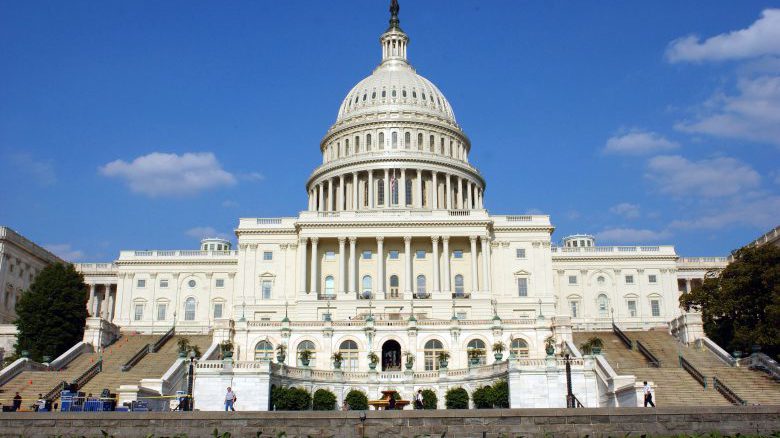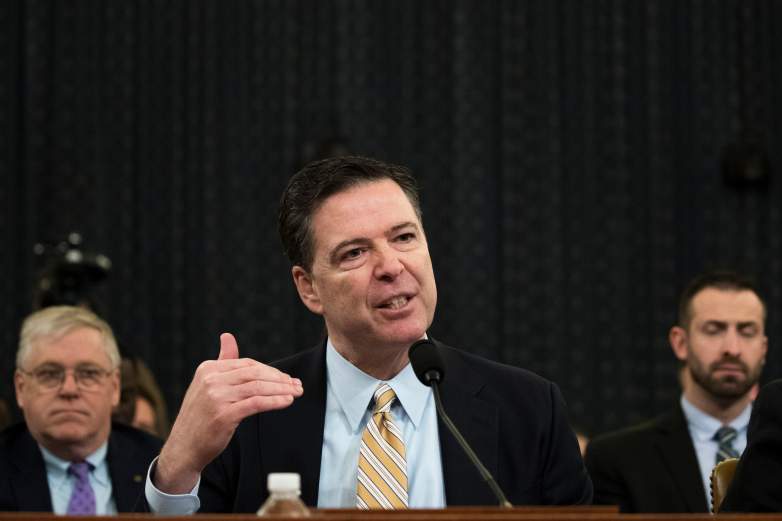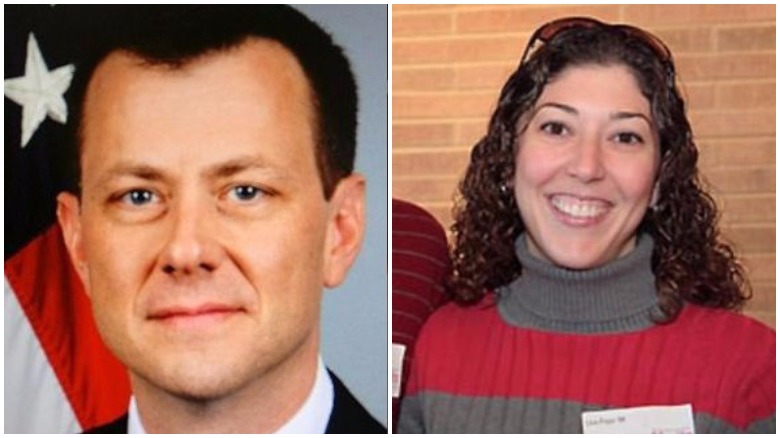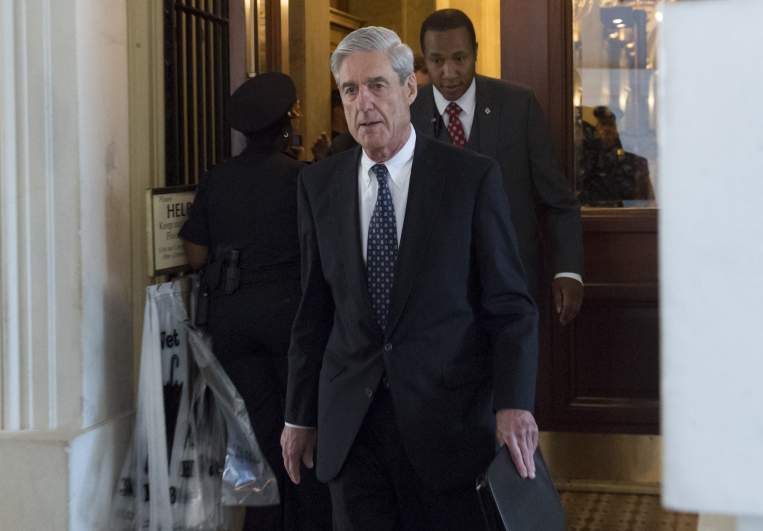
Getty The U.S. Capitol is shown June 5, 2003 in Washington, DC.
What’s being called the secret “FISA memo” was supposedly “worse than Watergate,” according to conservative Fox News host Sean Hannity and reveals KGB-like tactics, according to a GOP lawmaker. What does it show? The now released memo alleges that the FBI and U.S. Department of Justice relied on the controversial dossier created by a former British spy, Christopher Steele, to obtain a warrant to conduct surveillance on an adviser to the president’s presidential campaign.
You can read the memo here on the House website and below:
The memo, which has been hotly criticized by both the FBI and Democrats, further alleges that the DOJ and FBI failed to tell the court granting the warrant about the dossier’s political origins – namely that it was ultimately funded by the Hillary Clinton campaign and the Democratic National Committee through a law firm and the research firm, Fusion GPS. However, Democratic critics of the memo say that it lacks context and also shows that the investigation into a different Trump aide – George Papadoupolos – played a role in the Russia investigation.
“The ‘dossier’ compiled by Christopher Steele (Steele dossier) on behalf of the Democratic National Committee (DNC) and the Hillary Clinton campaign formed an essential part of the Carter Page FISA application,” the memo alleges. “Steele was a longtime FBI source who was paid over $160,000 by the DNC and Clinton campaign via the law firm Perkins Coie and research firm Fusion GPS, to obtain derogatory information on Donald Trump’s ties to Russia. Neither the initial application in October 2016, nor any of the renewals, disclose or reference the role of the DNC, Clinton campaign or any party/campaign in funding Steele’s efforts, even though the political origins of the Steele dossier were then known to senior DOJ and FBI officials.”
The memo says that the GOP findings “raise concerns with the legitimacy and legality of certain DOJ and FBI interactions with the Foreign Intelligence Surveillance Court (FISC)” and “represent a troubling breakdown of legal processes established to protect the American people from abuses related to the FISA process.”
The memo alleges that the FISA application did not mention “Steele was ultimately working on behalf of – and paid by – the DNC and Clinton campaign, or that the FBI had separately authorized payment to Steele for the same information.”
The memo alleges that, on Oct. 21, 2016, the DOJ and FBI “sought and received a FISA probable cause order…authorizing electronic surveillance of Carter Page from the FISC.” Page was a U.S. citizen and volunteer adviser to the Trump presidential campaign. Either the director of deputy director of the FBI had to first certify the application. The Attorney General, Deputy Attorney General, or the Senate-confirmed Assistant Attorney General for the National Security Division then had to sign off on it.
The FBI and DOJ obtained a FISA warrant targeting Carter Page and three FISA renewals from the FISC. FISA orders on American citizens have to be renewed every 90 days with a separate finding of probably cause. Then FBI director James Comey signed three FISA applications in question on the FBI’s behalf, Deputy Director Andrew McCabe signed one, then DAG Sally Yates, then Acting DAG Dana Boente, and DAG Rod Rosenstein each signed one or more FISA applications, according to the FISA memo.

GettyJames Comey.
The memo also alleges that the Carter Page FISA application “cited extensively” a September 23, 2016 Yahoo News article by Michael Isikoff on a trip that Page took to Moscow in July 2016. “The article does not corroborate the Steele dossier because it is derived from information leaked by Steele himself to Yahoo News,” the memo alleges. The application “incorrectly assesses that Steele did not directly provide information to Yahoo News. Steele has admitted in British court filings that he met with Yahoo News – and several other outlets – in September 2016 at the direction of Fusion GPS. Perkins Coie was aware of Steele’s initial media contacts because they hosted at least one meeting in Washington D.C. in 2016 with Steele and Fusion GPS where this matter was discussed.”
Steele “improperly concealed from and lied to the FBI about” his media contacts, the memo alleges.
Before and after Steele was terminated as an FBI source, he “maintained contact with DOJ via then-Associate Deputy Attorney General Bruce Ohr, a senior DOJ official who worked closely with Deputy Attorneys General Yates and later Rosenstein. Shortly after the election, the FBI began interviewing Ohr, documenting his communications with Steele. For example in September 2016, Steele admitted to Ohr his feelings against then-candidate Trump when Steele said he ‘was desperate that Donald Trump not get elected and was passionate about him not being president.”
Complicating matters more, Bruce Ohr’s wife, Nellie Ohr, was on the payroll of Fusion GPS. “During this same time period, Ohr’s wife (Nellie Ohr) was employed by Fusion FPS to assist in the cultivation of opposition research on Trump,” the memo alleges. “Ohr later provided the FBI with all of his wife’s opposition research, paid for by the DNC and Clinton campaign via Fusion GPS. The Ohrs’ relationship with Steele and Fusion FPS was inexplicably concealed from the FISC.”
The memo alleges that “Steele was suspended and then terminated as an FBI source for what the FBI defines as the most serious of violations – an unauthorized disclosure to the media of his relationship with the FBI in an October 30, 2016 Mother Jones article by David Corn.”
he head of the FBI’s counterintelligence division, Assistant Director Bill Priestap, said that corroboration of the Steele dossier was in its “infancy” at the time of the initial Page FISA application, the memo alleges. After Steele was terminated, an FBI source validation report “conducted by an independent unit within FBI assessed Steele’s reporting as only minimally corroborated.”
The FISA application “relied on Steele’s past record of credible reporting on other unrelated matters” but “it ignored or concealed his anti-Trump financial and ideological motivations,” the memo says. Deputy Director Andrew McCabe testified that “no surveillance warrant would have been sought from the FISC without the Steele dossier information.”
The Page FISA application also mentioned information regarding “fellow Trump campaign adviser George Papadopoulos, but there is no evidence of any cooperation or conspiracy between Page and Papadopoulos. The Papadopoulos information triggered the opening of an FBI counterintelligence investigation in late July 2016 by FBI agent Pete Strzok,” the memo reads.

U.S. Department of Justice/Ohio State UniversityPeter Strzok and Lisa Page.
The memo states that Strzok was reassigned by the Special Counsel’s Office to FBI Human Resources for “improper text messages with his mistress, FBI Attorney Lisa Page,” who is not related to Carter Page. The memo states that Page and Strzok “both demonstrated a clear bias against Trump and in favor of Clinton, whom Strzok had also investigated. The Strzok/Lisa Page texts also reflect extensive discussions about the investigation, orchestrating leaks to the media, and include a meeting with Deputy Director McCable to discuss an “insurance” policy against President Trump’s election.
Details of the memo’s contents were first reported in conservative media. New reports allege that the memo claims the FBI used an unverified dossier funded in part by the Hillary Clinton campaign to obtain a warrant to conduct surveillance on Donald Trump campaign advisers.
The reactions by GOP lawmakers who saw the four-page document early on had a lot of people wondering what’s in the memo that some say documents abuses in how the Department of Justice and FBI wielded the Foreign Intelligence Surveillance Act against Donald Trump campaign officials during the Obama administration.
Around noon on the east coast, it was reported that President Donald Trump had transferred the memo back to the House Intelligence Committee, meaning it will likely be released imminently.
On January 29, Republicans in the House Intelligence Committee voted to release the memo to the public. According to Fox News, President Trump has five days from that date to decide whether to block the memo’s release. If he does not object, the memo would be released.
Trump’s Chief of Staff John Kelly indicated on January 31 that Trump was going to release the memo. “It will be released here pretty quick, I think, and then the whole world can see it,” Kelly said, according to The Daily Caller. The FBI has expressed “grave” concerns about the memo’s release, saying it contains “material omissions of fact.”
Rep. Adam Schiff (D-CA) claimed that House Intelligence Committee Chairman Devin Nunes (R-CA) allegedly gave the White House a “secretly altered” version of the memo, as tensions heighten over its possible release.
Hannity and some GOP lawmkaers in Congress are leading the charge for the FISA memo’s release. “Our sources are telling us that the abuse of power is far bigger than Watergate,” Hannity said, according to Fox News. “Remember, Watergate was a third-rate break-in. What we’re talking about tonight is the systematic abuse of power, the weaponizing of those powerful tools of intelligence and the shredding of our Fourth Amendment constitutional rights.” Some lawmakers and others were using the hashtag #releasethememo on Twitter.
Democrats have decried the memo’s potential release, with Mike Quiqley of Illinois, calling it “a book report by a high school kid at 1 a.m. on two Red Bulls who hasn’t read the book.”

GettyFormer FBI Director Robert Mueller, special counsel on the Russian investigation, leaves following a meeting with members of the US Senate Judiciary Committee at the US Capitol in Washington, DC on June 21, 2017.
Some lawmakers were allowed to view it in private on January 18, sparking the hue and cry. According to The New York Daily News, “Members of the lower chamber of Congress were allowed to see a memo from the House intelligence committee on Thursday, with some voicing outrage about what they saw in a restricted room at the Capitol.”
“It is so alarming the American people have to see this,” Ohio Rep. Jim Jordan said to Fox News.
“It’s troubling. It is shocking,” North Carolina Rep. Mark Meadows said to the network. “Part of me wishes that I didn’t read it because I don’t want to believe that those kinds of things could be happening in this country that I call home and love so much.”
“You think about, ‘is this happening in America or is this the KGB?’ That’s how alarming it is,” Pennsylvania Rep. Scott Perry said to Fox. “I believe the consequence of its release will be major changes in people currently working at the FBI and the Department of Justice,” said Florida Rep. Matt Gaetz to Fox.

(Getty)
Rep. Mark Meadows of North Carolina wrote on Twitter, “I viewed the classified report from House Intel relating to the FBI, FISA abuses, the infamous Russian dossier, and so-called “Russian collusion.” What I saw is absolutely shocking. This report needs to be released–now. Americans deserve the truth. #ReleaseTheMemo.”
Rep. Ron DeSantis also called for the memo’s release, writing, “The classified report compiled by House Intelligence is deeply troubling and raises serious questions about the upper echelon of the Obama DOJ and Comey FBI as it relates to the so-called collusion investigation.”

